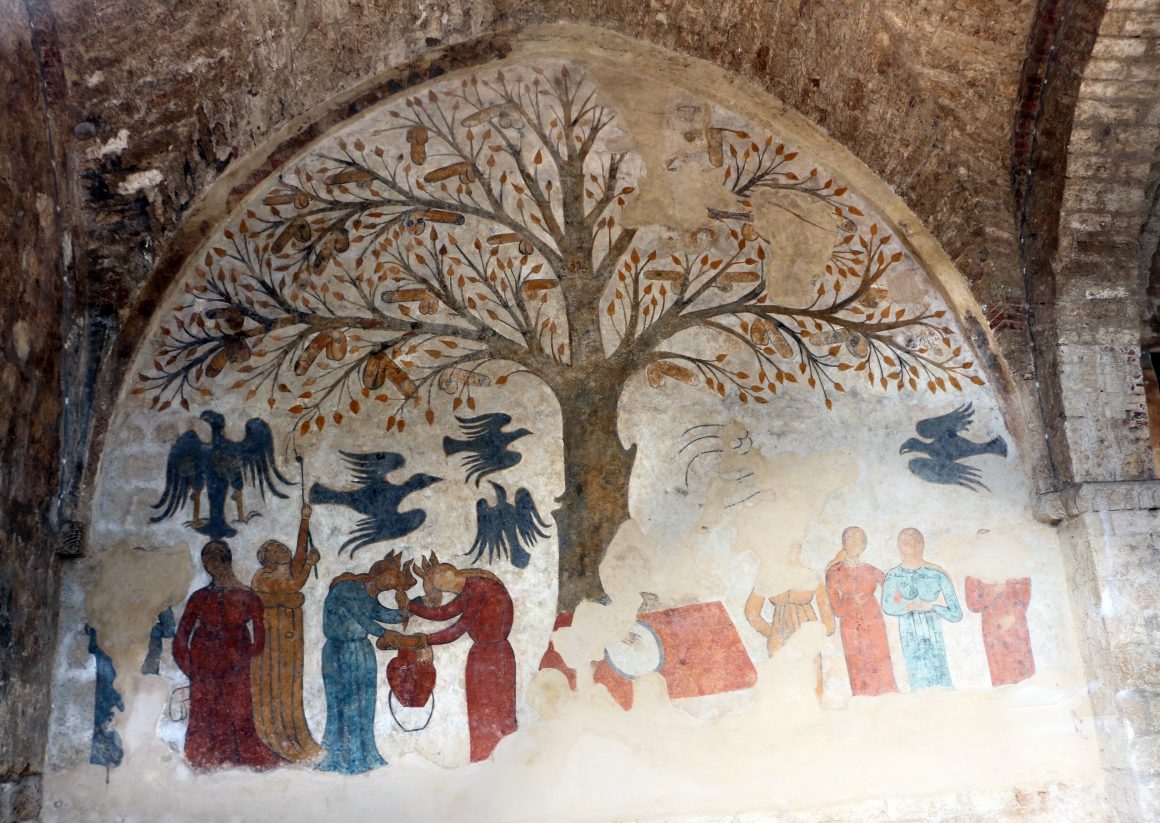
Rediscovering the roots of sexuality webinar with CLARE
By May Domingo, November 18 2020—
Behind layers of minerals, moss and overpaint, a mural depicting sexuality and religion was rediscovered in Massa Marittima, Italy. Dr. George Ferzoco, a professor in the University of Calgary’s Department of Classics and Religion, partnered with the Calgary Public Library to explore religion in ways that go beyond witchcraft and eroticism.
Ferzoco provided a webinar with the hope of enlightening any and all people who were interested in the mural’s capturing of sexuality in the Medieval Ages.
The webinar began with the quote, “the medium is the message,” a famous saying by Canadian philosopher Marshall McLuhan. Ferzoco spoke about the importance of word-of-mouth and how it impacts how people understand and process information.
“People read what they want to see,” Ferzoco said as he referred to The Beatles conspiracy theory in 1966. Hence, murals were placed in obvious places as the artists’ or commissioners’ way of encouraging people to talk about art and the representations within it.
With this intention, Ferzoco virtually brought the audience to Massa Marittima, a small Italian town just south of Tuscany. From 1225–1335 this town was its own republic and was ruled by its own people. It had a plaza, a church, a police station, a town hall, a market and a Bishop’s palace. However, the most important location was the town water fountain.
It was important for a town to protect their fountain as it provided a natural resource and was used for sanitation and agriculture. Therefore, to besiege a town, the water source was often conquered first and foremost. As well, a mural beside a water fountain was a great way to spread a government’s message subtly. Everyday, a member of each family, specifically women, would go out to collect water for the day. These women might start talking about the mural and eventually spread word about the image.
It took about 600 years for this special water fountain to be rediscovered. What made it special was the symbolism portrayed on a seemingly ordinary seven-foot mural. Painted behind the town fountain was a large tree surrounded by black birds and eight women. Many named it the Tree of Fertility.
Upon closer examination, viewers will notice that male genitalia is sprouting from the tree branches. Ferzoco remarked that art portraying human genitalia was an acceptable thing in this period. Our predecessors did not see this to be obscene. Most towns even have male genitalia sculptures as a welcome greeting for travellers.

The professor proposed that the mural is possibly detailing that fertility surrounds us.
“You’ve got water that gives life, you’ve got this primordial image of a tree that gives fruit, and of course the penis, which is one of the things that biologically gives life as well.”
However, this 13th Century mural provides more context aside from simply fertility. The black birds flying above the women are noted to be eagles, a symbol of the Holy Roman Emperor. The importance of this symbol lies in the historical context that Ferzoco explained during the webinar.
Ghibellines, the Holy Roman Emperor’s followers, and Guelphs, the Pope’s followers, were constantly in conflict due to their incompatible views on femininity.
The Guelphs would have turned away in disgust if they were ever to see this mural. Ferzoco said that this is because they believed that women should not be aggressive or lustful. These women would have been viewed to be evil heretics.
That perception would have been further emphasized by the women under the tree. Four women on the left were either fighting for a penis, being sodomized, or picking “fruit” from the tree. In addition, each of the four women was directly underneath a symbol of the Holy Roman Emperor.
“They are portrayed as falling under a bad influence,” Ferzoco said. Contrastingly, four identical women stood demurely.
Women with unnatural desires, as depicted in the mural, were called witches. The label of a witch itself was only revealed 200 years later in Heinrich Kramer’s Malleus Maleficarum. Ferzoco clarified that these women were considered witches because they go against the Christian teachings of purity.
There is also the trace of a serpent to the right of the tree.
“The most obvious story that comes up is the original sin of Adam and Eve in the Garden of Eden,” said Ferzoco.
In this particular mural, the demure women have not been seduced by the serpent yet and therefore are not viewed to be heretics in the eyes of the Guelphs. Ferzoco said that such symbols surrounding any tree in an artwork can be a “deliberate echo of something that goes back to the beginning of our cultural DNA.”
The conflict between religion and politics was wrapped up in fertility and women’s bodies even then. Yet, it still seems to have an impact on how the world views sexuality today.
Ferzoco expounds on the idea that we are still living in a theocracy, despite most states being democratic. On a Canadian dollar, the words “D.G. Regina” are engraved.
“It’s the Latin abbreviation for ‘by the grace of God,’” Ferzoco translated. Though he admits that this observation could be a stretch, it confirms our society’s way of accepting the legal framework of the Queen’s representation as the grace of God.
Ferzoco has taught in England for the past 26 years, having only moved to Calgary two months ago.
“I think everyone should study, at least a bit, religion. In studying religion, not only do you learn what makes other people tick and how you understand why they do what they do,” Ferzoco expressed when asked about the importance of religion. “More importantly, it makes you sensitive to different ways of looking at reality. You learn from all of these different vantage points. It can pay off and make one, maybe not a stereotypically good person, but certainly a wiser person.”
Indeed, a wiser person would be curious about what religion can teach us about sexuality. Religion has a complicated history. It’s many depictions through medieval murals and spread through word-of-mouth have created many complex understandings on sexuality. Though that is the fact, religion has and could reveal the evolution of our cultural DNA and why the world has turned away from openly talking about sexuality. This is a question Ferzoco hopes to explore in the future.
